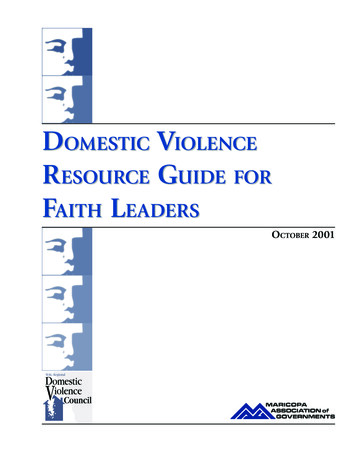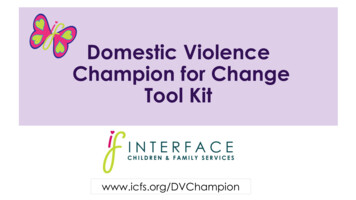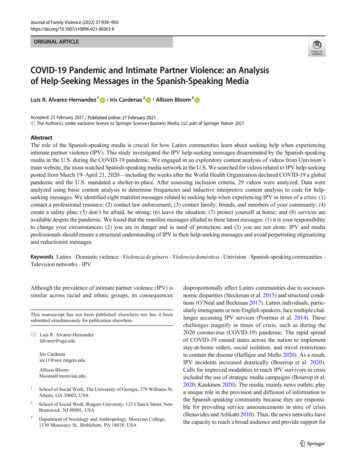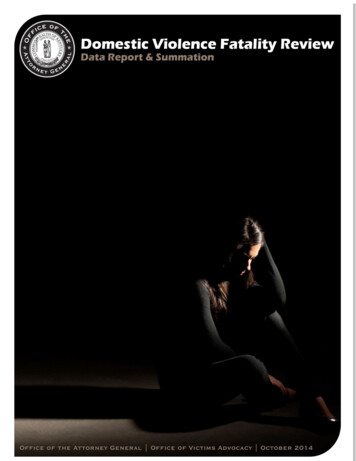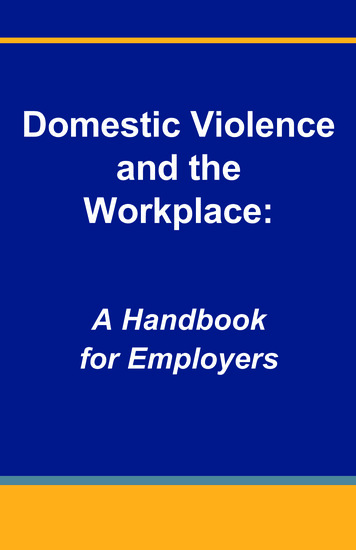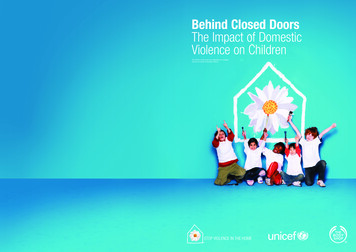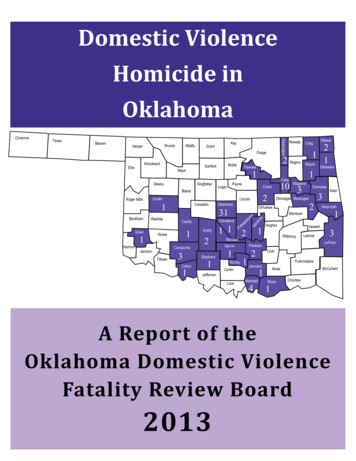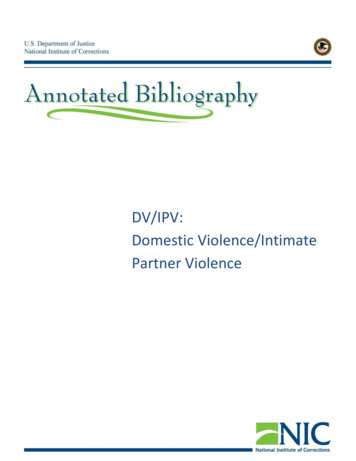
Transcription
DV/IPV:Domestic Violence/IntimatePartner ViolenceWorkplace Learning Annotated BibliographyPage 1
DV/IPV: Domestic Violence/Intimate Partner ViolencePrepared by the NIC Information CenterDate updated February 2018ContentsIntroduction . 2General. 3Assessment Instruments . 9Community Corrections . 13Courts . 16State Statutes . 22Juveniles . 24Family Programs. 29Victim Behaviors . 33Victim Programs & Services . 38Program Evaluations . 48Treatment (Perpetrators) . 57Safety Planning/Plans . 68Confidentiality . 71Resource Centers . 73Domestic Violence/Intimate Partner ViolencePage 1
IntroductionDomestic violence is the willful intimidation, physical assault, battery, sexual assault, and/or otherabusive behavior as part of a systematic pattern of power and control perpetrated by one intimatepartner against another. It includes physical violence, sexual violence, psychological violence, andemotional abuse. The frequency and severity of domestic violence can vary dramatically; however, theone constant component of domestic violence is one partner’s consistent efforts to maintain power andcontrol over the other.In the United States, an average of twenty people are physically abused by intimate partners everyminute. This equates to more than ten million abuse victims annually. Domestic violence affectseveryone regardless of age, socio-economic status, sexual orientation, gender, race, religion ornationality and has devastating consequences that last a lifetime. Nearly 3 in 10 women (29%) and 1 in 10 men (10%) in the US have experienced rape, physicalviolence and/or stalking by a partner and report a related impact on their functioning. Nearly, 15% of women (14.8%) and 4% of men have been injured as a result of IPV that includedrape, physical violence and/or stalking by an intimate partner in their lifetime. Females ages 18 to 24 and 25 to 34 generally experienced the highest rates of intimate partnerviolence. Most female victims of intimate partner violence were previously victimized by the sameoffender, including 77% of females ages 18 to 24, 76% of females ages 25 to 34, and 81% offemales ages 35 to 49. Law enforcement officer fatality rates are greatly increased when responding to domesticviolence incidents when a firearm is present. (2017 Mid-Year Law Enforcement Officer FatalitiesReport)In response to this continuing issue and its impact on the corrections environment, the NationalInstitute of Corrections will highlight innovative and promising programs that address offenderaccountability and victim safety in domestic violence cases both in institutional and communitysupervision settings: Provide information about designing a comprehensive post-conviction domestic violenceresponse program for both offenders and victims.Steps and tools to identify and prioritize your response to offender behavior.Provide resources specifically tailored to the correctional .thehotline.org/resources/statistics/Domestic Violence/Intimate Partner ViolencePage 2
GeneralAhmed, Awad Mohamed, et al. “Brief Tips on Domestic Violence: Basic Facts to Understand itsDynamics.” Clinical Psychiatry 3, no. 2(2016). Accessed June 23, 2017, -dynamics.pdf.Provides 12 basic facts of domestic violence.Apples to Oranges: Comparing Survey Findings from Selected National Surveys on Intimate PartnerViolence. Harrisburg, PA: VAWnet, a project of the National Resource Center on Domestic Violence,2012, e-partner.Contextual and methodological differences among surveys contribute to differences inestimates of the incidence and prevalence of intimate partner violence.Bair-Merritt, Megan, et al. “Why Do Women Use Intimate Partner Violence? A Systematic Review ofWomen’s Motivations.” Trauma Violence Abuse 11, no. 4(2010): 178-189. Accessed June 20, 994556/.Studies report that women use as much or more physical intimate partner violence (IPV) asmen. A systematic review therefore was conducted to summarize evidence regarding women’smotivations for the use of physical IPV in heterosexual relationships.Breiding, Matthew J., et al. Intimate Partner Violence Surveillance Uniform Definitions andRecommended Data Elements Version 2.0. Atlanta, GA: National Center for Injury Prevention andControl, Centers for Disease Control and Prevention, tepartnerviolence/definitions.html.This is a set of recommendations designed to promote consistency in the use of terminology anddata collection related to intimate partner violence.Breiding, Matthew J., et al. Prevalence and Characteristics of Sexual Violence, Stalking, and IntimatePartner Violence Victimization—National Intimate Partner and Sexual Violence Survey, United States,2011. Atlanta, GA: National Center for Injury Prevention and Control, Centers for Disease Control andPrevention, 2014, .htm.This report describes the most recent data on the public health burden of sexual violence,stalking, and intimate partner violence victimization and the characteristics of victimization.Brown, Taylor N.T., and Jody L. Herman. Intimate Partner Violence and Sexual Abuse among LGBTPeople: A Review of Existing Research. Los Angeles, CA: The Williams Institute, UCLA School of Law,2015, buse-among-lgbt-people/.This report provides an overview of existing research on intimate partner violence (IPV) andsexual abuse (IPSA) among lesbian, gay, bisexual, and transgender (LGBT) people and makesrecommendations for future research.Catalano, Shannon. Intimate Partner Violence: Attributes of Victimization, 1993-2011. Washington, DC:Bureau of Justice Statistics (BJS), 2013, https://www.bjs.gov/index.cfm?ty pbdetail&iid 4801.Domestic Violence/Intimate Partner ViolencePage 3
Presents data on trends in nonfatal intimate partner violence among U.S. households from 1993to 2011.Chibber, Karuna, Jeremy Cantor, and Eliana Greenberg. Domestic Violence Literature Review: AnalysisReport. Boston, MA: JSI Research & Training Institute, Inc., 2016,http://www.jsi.com/JSIInternet/Inc/Common/ download pub.cfm?id 17269&lid 3.The objective of JSI’s literature review and analysis was to address the following questions: 1.What is the evidence about the prevalence of DV? 2. What is known about the healthconsequences of exposure to DV? 3. What is the evidence about DV as a driver of health carecosts? 4. What are the outcomes from interventions integrating DV response systems withhealth care? 5. What are the lessons learned from other sectors? This report presents asynthesis of findings from the literature review analysis for each question.Covington, Stephanie S. Justice-Involved Women: Understanding Trauma and Violence [Webinar].Philadelphia, PA: National Clearinghouse for the Defense of Battered Women (NCDBW), 2014,http://nicic.gov/library/029601.This webinar will: describe violent female offenders; define trauma-informed and genderresponsive services; describe the social-ecological model of violence; describe the theoreticalfoundation of Beyond Violence; discuss the evidence-base and research on Beyond Violence;and introduce the Beyond Violence curriculum.Derrington, Rachel, et al. Making Distinctions between Different Types of Intimate Partner Violence: APreliminary Guide. Fairfax, VA: National Healthy Marriage Resource Center (NHMRC) and NationalResource Center on Domestic Violence (NRCDV), epreliminary-guide.This paper summarizes discussions held at an invitational conference designed to bring togetherkey scholars and practitioners from the healthy marriage and domestic violence fields to addressa complex issue-different types of intimate partner violence and their implications for practice.Domestic Violence: Understanding the Basics. Harrisburg, PA: National Resource Center on DomesticViolence and VAWnet, the National Online Resource Center on Violence against Women, understanding-basics.This one hour interactive eLearning module describes the dynamics and common tactics thatcharacterize domestic violence, provides an overview of the scope and impact on individualsand society, explores the underlying factors that allow domestic violence to exist, offers insightinto the various risks and choices that survivors face, and shares how to be part of the solution.Domestic Violence & Sexual Assault in the United States: A Human Rights Based Approach & PracticalGuide. New York, NY: American Civil Liberties Union (ACLU) Women’s Rights Project, ice-guide.This guide provides an overview of human rights law’s approach to addressing gender-basedviolence.Gamache, Denise, and Rhonda Martinson. Ending Gender Bias in the Law Enforcement Response toSexual Assault and Domestic Violence. Minneapolis, MN: Battered Women’s Justice Project, estic Violence/Intimate Partner ViolencePage 4
Discussion on how to implement guiding principles issued by the Department of Justice (DOJ) onthe identification and prevention of gender bias in the law enforcement response to sexualassault and domestic violence.Ganley, Anne, and Margaret Hobart. Social Worker’s Practice Guide to Domestic Violence. Seattle, WA:Washington State Coalition against Violence, 2010, e-guide-to-domestic-violence/.The guide provides relevant research, practice recommendations and information regardingcommunity supports to help social workers implement domestic violence-specific policies ofChildren’s Administration, Washington State Department of Social and Health Services.Gerlock, April. Caregivers, Military Veterans and Intimate Partner Violence [Webinar]. Minneapolis, MN:Battered Women’s Justice Project, 2016, s/caregivers-vets-and-ipv.html.This webinar examines the complex issues surrounding caregiver engagement and safety whencaring for a combat-injured service member or veteran partner; when IPV is also present.Global and Regional Estimates of Violence against Women: Prevalence and Health Effects of IntimatePartner Violence and Non-Partner Sexual Violence. Geneva, Switzerland: World Health Organization(WHO), 2013, /violence/9789241564625/en/.This report presents the first global systematic review and synthesis of the body of scientificdata on the prevalence of two forms of violence against women — violence by an intimatepartner (intimate partner violence) and sexual violence by someone other than a partner (nonpartner sexual violence).Guidance for Agency-Specific Domestic Violence, Sexual Assault, and Stalking Policies. Washington, DC:United States Office of Personnel Management, 2013, ased/.This provides agencies with direction to enable them to fulfill the goals identified in thePresidential Memorandum on “Establishing Policies for Addressing Domestic Violence in theFederal Workforce,” which was issued on April 18, 2012.Hart, Barbara J., and Andrew R. Klein. Practical Implications of Current Intimate Partner ViolenceResearch for Victim Advocates and Service Providers. Rockville, MD: National Criminal Justice ReferenceService (NCJRS), 2013, pdf.This report uses a question-and-answer format to inform victim advocates and service providersof the findings of published research on intimate partner violence (IPV) and their relevance forpractice.Hasstedt, Kinsey, and Andrea Rowan. “Understanding Intimate Partner Violence as a Sexual andReproductive Health and Rights Issue in the United States.” Gottmacher Policy Review 19(2016): 37-45.Accessed October 3, 2016, e-health-and-rights-issue.An increasing body of evidence demonstrates the importance of understanding and addressingIPV as a critical component of sexual and reproductive health and rights (SRHR) in the UnitedStates.Domestic Violence/Intimate Partner ViolencePage 5
Ingham, Mary. What Advocates Need to Know About Law Enforcement’s Role (Part 1: CCR ProblemSolving Series: The Role of Law Enforcement) [Webinar]. Minneapolis, MN: Battered Women’s JusticeProject, 2017, s/what advocates need to know about law enforcement role part 1.html.The presenters will: discuss the building blocks of a good relationship between law enforcementand advocacy, illuminate the vocabulary and jargon commonly used by police officers, discusspolice culture, and share how police implement their many directives.Ingham, Mary, and Chief Deputy David Hepperly. Advocate Lessons: How Law Enforcement Respond toand Investigates Domestic Violence Cases (Part 2: CCR Problem-Solving Series: The Role of LawEnforcement) [Webinar]. Minneapolis, MN: Battered Women’s Justice Project, esults/how law enforcement responds to and investigates domestic violence cases.html.This second webinar in BWJP’s CCR Problem-Solving Series builds upon the initial discussion oflaw enforcement response and specifically explores the role and responsibilities of lawenforcement in their initial response to domestic violence cases.Klein, Andy, et al. Impact of Differential Sentencing Severity for Domestic Violence Offenses and All OtherOffenses over Abusers’ Life Spans. Rockville, MD: National Criminal Justice Reference Service (NCJRS),2014, pdf.The goal of this research is to revisit the question of the effectiveness of DV prosecution.Lambson, Suvi Hynynen, and Warren Reich. Intimate Partner Violence as a Community Problem:Community Perspectives from Bedford-Stuyvesant, Brooklyn. New York, NY: Center for Court Innovation,2017, http://www.courtinnovation.org/ipv bed-stuy?url research%2F7%2Fall&mode 7&type all.This study documents perceptions of intimate partner violence in the Bedford-Stuyvesantneighborhood of Brooklyn, New York.Logan, T. Research on Partner Stalking: Putting the Pieces Together. Lexington, KY: University ofKentucky, Department of Behavioral Science & Center on Drug and Alcohol Research, talking-putting-pieces-together.This report provides a general overview of the current research on partner stalking and some ofthe prominent research trends.Models in Prevention: CDC’s DELTA Program. Harrisburg, PA: VAWnet, a project of the National ResourceCenter on Domestic Violence, 2012, program.This collection highlights the successes of this program and its grantees, providing materials tosupport replication of these efforts across the United States and globally.Modi, Monica N., Sheallah Palmer, and Alicia Armstrong. “The Role of Violence against Women Act inAddressing Intimate Partner Violence: A Public Health Issue.” Journal of Women’s Health 23, no. 3(2014): 253-259. Accessed June 20, 2016, 4/.This review examines the role of legislation and addresses proposals for helping victims of IPV.National Victim Assistance Academy Resource Paper: Intimate Partner Violence. Fairfax, VA: Office forVictims of Crime Training and Technical Assistance Center (OVC TTAC), sID 41.Domestic Violence/Intimate Partner ViolencePage 6
After providing a summary of statistics on the prevalence and features of intimate-partnerviolence (IPV) in the United States, this paper defines terms used in discussions of IPV, followedby sections that address IPV’s unique impact/effects on victims, effective responses for victimsupport and advocacy, cultural issues and barriers to reporting IPV and accessing victims’services, and collaborative responses and resources.Oehme, Karen, Stephanie Grace Prost, and Daniel G. Saunders. “Police Responses to Cases of OfficeInvolved Domestic Violence: The Effects of a Brief Web-Based Training.” Policing 10, no. 4(2016): 391407. Accessed June 19, 2017, 16/02/Policing-2016Oehme.pdf.This study investigated responses of officers (n 852) to case scenarios of OIDV before and afterthey participated in the National Prevention Toolkit on OIDV, an online training.Rivera, Echo A., et al. The Relationship between Intimate Partner Violence and Substance Use: An AppliedResearch Paper. Chicago, IL: National Center on Domestic Violence, Trauma & Mental Health, rch-paper/.This paper provides a summary of recent research on the relationship between intimate partnerviolence and substance use or substance use disorders.Smith, S. G., et al. National Intimate Partner and Sexual Violence Survey (NISVS) – 2010-2012 StateReport. Atlanta, GA: National Center for Injury Prevention and Control, Centers for Disease Control andPrevention, 2017. ryreports.html.This report uses the NISVS data from 2010-2012 to produce national and state victimizationestimates for intimate partner violence, sexual violence, and stalking.Truman. Jennifer L., and Lynn Langton. Criminal Victimization, 2013. Washington, DC: Bureau of JusticeStatistics (BJS), 2014, http://nicic.gov/library/028467.This report presents 2013 estimates of rates and levels of criminal victimization in the UnitedStates.Taking Action to Prevent Intimate Partner Violence and Sexual Violence: Creating Statewide PreventionPlans. Atlanta, GA: Centers for Disease Control and Prevention, ating-statewide-prevention-plans2-a.pdf.Primary prevention requires comprehensive, coordinated, and sustained efforts of multiple,diverse organizations and stakeholders.Warshaw, Carole, Cris M. Sullivan, and Echo A. Rivera. A Systematic Review of Trauma-FocusedInterventions for Domestic Violence Survivors. National Center on Domestic Violence, Trauma & MentalHealth, 2013, ment-in-the-context-of-domestic-violence/.This paper reviews the trauma-based treatments that have been designed or modifiedspecifically for IPV survivors and provides cautions and recommendations for moving forward.When Men Murder Women: An Analysis of 2015 Homicide Data. Washington, DC: Violence Policy Center(VPC), 2017, http://www.vpc.org/studies/wmmw2017.pdf.More than 1,600 women were murdered by men in 2015 and the most common weapon usedwas a gun, according to this new Violence Policy Center (VPC) study.Domestic Violence/Intimate Partner ViolencePage 7
Ybarra, Michele, et al. Intimate Partner Digital Abuse. New York, NY: Data & Society Research Instituteand San Clemente, CA: Center for Innovative Public Health Research (CiPHR), 2017,https://datasociety.net/pubs/oh/Intimate Partner Digital Abuse 2017.pdf.This report, part of a series of research reports on digital harassment and abuse, examines theprevalence and impact of intimate partner digital abuse.Domestic Violence/Intimate Partner ViolencePage 8
Assessment InstrumentsAssessing Patients for Sexual Violence: A Guide for Health Care Professionals. Enola, PA: National SexualViolence Resource Center (NSVRC), 2011, ts-sexualviolence-guide-health-care-providers.This guide aims to build on those tools and encourage health care providers to conduct fullassessments with patients to encourage interventions that provide adequate treatments andrecommendations for survivors of sexual violence.Capaldi, Deborah M., et al. “A Systematic Review of Risk Factors for Intimate Partner Violence.” PartnerAbuse 3, no. 2(2012): 231-280. Accessed June 14, 3384540/.The purpose of this study was to provide a comprehensive compilation and systematic review ofstudies involving risk factors for IPV, including the perpetration of physical, psychological, andsexual abuse.DOCCR Validation of Two Domestic Violence Risk Instruments: Domestic Violence Screening Instrument(DVSI) & Spousal Abuse Risk Assessment (SARA). Hennepin County, MN: Hennepin County Departmentof Community Corrections & Rehabilitation, 2011, http://www.hennepin.us/ mmary.pdf?la en.In 2001, the Department of Community Corrections and Rehabilitation began usingtwo specialized domestic abuse risk assessment tools in its Domestic Violence Unit: TheDomestic Violence Screening Instrument (DVSI), a twelve-item scale with a high score range of30 that was developed for use as a domestic violence risk screening tool; and the Spousal AbuseRisk Assessment (SARA), a case management tool used for those offenders who have beenpreviously screened as high risk for domestic related re-offense through administration of theDVSI.Farrell, Helen M. “Batterers: A Review of Violence and Risk Assessment Tools.” The Journal of AmericanAcademy of Psychiatry and the Law 39(2011): 562-564. Accessed June 20, 2016,http://jaapl.org/content/39/4/562.long.This article serves to bring awareness of the many factors, including neurobiology andneuropsychology, that contribute to the development of a batterer.Gover, Angela R., Tara N. Richards, and Elizabeth A. Tomsich. Colorado’s Innovative Response toDomestic Violence Offender Treatment: Current Achievements and Recommendations for the Future.Denver, CO: Buechner Institute for Governance, 2015, ctory/Colorado%20Crime%20Briefing Richards.pdf.This report reviews the process and risk assessment tool (Domestic Violence Risk andNeeds Assessment – referred to hereafter as DVRNA) used in Colorado to assign domesticviolence offenders to treatment intensity levels at intake and the decision-making processesregarding treatment outcomes.Grant, Tanya M., and Bronwyn Cross-Denny. “Lethality Assessment Protocol: Police Perceptions of aDomestic Violence Intervention.” Criminal Justice Review (2017): 1-16. Accessed August 4, 734016817699672.Domestic Violence/Intimate Partner ViolencePage 9
This exploratory, qualitative research study examined the attitudes and barriers police officersidentified in successful implementation of the lethality assessment protocol (LAP), acollaborative intervention between police departments and domestic violence advocacyagencies in the state of Connecticut.Hamberger, Kevin L., Karin Rhodes, and Jeremy Brown. “Screening and Intervention for Intimate PartnerViolence in Healthcare Settings: Creating Sustainable System-Level Programs.” Journal of Women’sHealth 24, no. 1(2015): 86-91. Accessed June 23, /jwh.2014.4861.Description of a systems-level intervention model that may overcome the obstacles to routinescreening for intimate partner violence (IPV).Iverson, Katherine M., et al. “Clinical Utility of an Intimate Partner Violence Screening Tool for FemaleVHA Patients.” Journal of General Internal Medicine 28, no. 10(2013): 1288-1293. Accessed June 20,2016, 9/.This study evaluated the accuracy of a brief IPV victimization screening tool for use with femaleVeterans Health Administration (VHA) patients.Johnson, Kate. Risk Assessment Skills for Advocates [Webinar]. Minneapolis, MN: The Battered Women’sJustice Project, 2013, ts/risk-assessment-skills-foradvocates.html.A four-stage process for conducting risk assessments with victims will be presented.Kercher, Glen, Andrea Weiss, and Katrina Rufino. Assessing the Risk of Intimate Partner Violence.Huntsville, TX: The Crime Victims’ Institute, Sam Houston State University, Criminal Justice Center, 2010,http://www.ncdsv.org/images/CVI Assessing-the-Risk-of-IPV 1-2010.pdf.The central purpose of this report is to identify the predictors of IPV and to assess the accuracyof different approaches and models in predicting risk of future harm or lethality to victims.Koppa, Vijetha. “Can Domestic Violence Victim Screening and Active Safety Counseling Save Lives?”2016. Accessed June 23, 2017, https://papers.ssrn.com/sol3/papers.cfm?abstract id 2982227.This paper studies the effectiveness of the Lethality Assessment Program (LAP) program byexploiting the variation in the timing of implementation of it across law enforcement agencies inMaryland, where the program was first developed. Results indicate that the program reducedfemale homicide victimization by males by 35-45 percent [Abstract].Kraanen, Fleur L., et al. “Screening on Perpetration and Victimization of Intimate Partner Violence (IPV):Two Studies on the Validity of an IPV Screening Instrument in Patients in Substance Abuse Treatment.”PLOS One 8, no. 5(2013): e63681. Accessed June 20, 656036/.The development of a four-item screening instrument; the Jellinek Inventory for assessingPartner Violence (J-IPV).Labrecque, Ryan M. Domestic Violence Risk Assessments: Considerations for Selection and Use. Salem,OR: Portland State University, tent.cgi?article 1024&context ccj fac.Presentation to the House and Senate Judiciary Committees on May 25, 2016 in Salem, Oregon.Domestic Violence/Intimate Partner ViolencePage 10
Luppi, Faye, and Julia Colpitts. A Roadmap to Risk Assessment: ODARA and Maine’s CCR [Webinar].Minneapolis, MN: The Battered Women’s Justice Project, 2014, cr.html.Presenters describe the year-long process leading to the recommendation that Maine riskassessment practice be updated to include the Ontario Domestic Assault Risk Assessment(ODARA) tool.Messing, Jill Theresa, and Jonel Thaller. “The Average Predictive Validity of Intimate Partner ViolenceRisk Assessment Instruments.” Journal of Interpersonal Violence 28, no. 7(2013): 1537-1558. AccessedJune 20, la Waters 013.pdf.This study examines the average predictive validity weighted by sample size of five stand- aloneIPV risk assessment instruments that have been validated in multiple research studies using theReceiver Operating Characteristic Area Under the Curve (AUC).Messing, Jill Theresa, et al. Police Departments’ Use of the Lethality Assessment Program: A QuasiExperimental Evaluation. Rockville, MD: National Criminal Justice Reference Service (NCJRS), ation-detail.aspx?ncjnumber 247456.Under LAP, a police officer responding to the scene of a domestic violence incident uses a brief11-item risk assessment to identify victims at high risk for homicide victimization.Risk A
Discussion on how to implement guiding principles issued by the Department of Justice (DOJ) on the identification and prevention of gender bias in the law enforcement response to sexual assault and domestic violence. Ganley, Anne, and Margaret Hobart. Social Workers Practice Guide to Domestic Violence. Seattle, WA:
